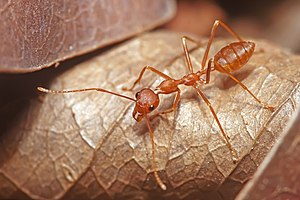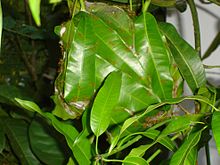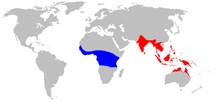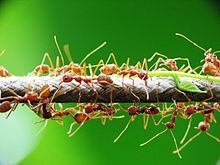Oecophylla smaragdina
| Oecophylla smaragdina | ||||||||||||
|---|---|---|---|---|---|---|---|---|---|---|---|---|

Worker |
||||||||||||
| Systematics | ||||||||||||
|
||||||||||||
| Scientific name | ||||||||||||
| Oecophylla smaragdina | ||||||||||||
| ( Fabricius , 1775) |
Oecophylla smaragdina (also Asian weaver ant ) is a type of scale ants from the genus of weaver ants . Characteristic and eponymous for weaver ants is the construction of a silk nest, a free nest made of leaves that are " woven " togetherwith silk threads producedby the larvae . The distribution area extends from India to Northern Australia . Its sister species Oecophylla longinoda is native to tropical Africa.
Oecophylla smaragdina lives predatory and on animal carrion. The ants are defensive, they bite and spray formic acid .
description
The queen has a body length of 13 to 16 mm, is greenish and initially winged. The males are 6 to 6.5 mm long, black in color and winged. The workers can be quite different in shape, mostly reddish to orange, in Northern Australia with a green abdomen, their body length can be up to 9.5 mm. Workers of very different heights live together within a nest. The genus is notable within the Formicinae for the very long and narrow petiolus , which is not raised like scales, and the legs are unusually long and slender. The workers' complex eyes are very large. The long and slender antennae are twelve-limbed with a very long scapus , their point of inflection is far from the edge of the clypeus , the end limbs do not form a club. The mandibles have ten or more teeth, with a large terminal tooth. The animals have maxillary palps with five and labial palps with four segments. There are no thorns or teeth on either the trunk or the propodeum .
The species can usually be distinguished from the second species of the genus, Oecophylla longinoda , on the basis of its range (no known sympatric occurrences). Morphological differences are: In Oecophylla smaragdina the petiolus is flatter, its ventral surface is flat, not convex as in Oecophylla longinoda . In addition, the petiolus' stigmas are very prominent when viewed from above.
Country

The states of Oecophylla smaragdina can be very large and comprise up to a hundred silk nests with a total of around 500,000 animals in, for example, 21 larger trees on an area of 1500 m 2 . The territorial demarcation of states among one another takes place via complex communication patterns.
Most states only host one queen, they are monogynous . Some, especially in northern Australia, can also be polygynous and have up to six queens. The emergence of polygyny is seen as a strategy to compensate for the loss of a queen due to parasite infestation .
Nests and nest building
To build nests, workers of the large morphs (so-called majores) swarm out in suitable parts of the treetop. Here they try to pull the edges or tips of living, green leaves towards them. If a worker succeeds in doing this, others begin to support her. In order to attract leaves that grow further away to the resulting structure, the animals can form long chains in which the animals climb over each other and then hold onto the petiolus of their nestmates with their mandibles. Often a large number of such chains work parallel to each other, which can develop considerable tensile forces. Although other ant species also form teams, this chain formation is only known from the genus Oecophylla . When enough leaves are pulled together into a tent-like structure, some workers hold them in shape like living staples. Others begin by bringing in larvae from neighboring existing nests. With the silk produced by the larvae, they spin the leaves together. Only younger larvae of the third larval stage give off silk threads, they have greatly enlarged silk glands. Oecophylla no longer uses it for the usual function of silk, the construction of cocoons for pupation . The worker carries the motionless larva in her mandibles and moves it back and forth across the gap like a shuttle . In addition, silk walls are spun to close any remaining gaps. Often, tunnel-like galleries are created to other nests. In addition, protective pavilions for scale insect colonies are being built, and the ants feed on their excretions.
Relationships with other organisms
Symbiosis: Symphyly (trophobiosis)
There is a symbiosis in the form of a Symphylie as trophobiosis to the obligate myrmecophile Bläuling Anthene emolus . Blue females are stimulated to lay their eggs by the presence of Oecophylla smaragdina . The hatching larvae are carried by the ants into pavilions where they find food and are constantly cared for. In the third and fourth larval stage, the larvae secrete an energy-rich body fluid with approx. 200 joules per caterpillar, which the ants eagerly ingest. After pupation there is no longer any attractiveness, but the butterfly pupae are not attacked by the ants (one speaks of probiosis ). The hatching Anthene emolus enjoy no protection and are sometimes preyed on by Oecophylla smaragdina .
Oecophylla smaragdina are aphidophil , that is, they often live with myrmecophile Schnabelkerfen together trophobiotically that protect them and from which they exzernierte obtain nutrients. Trophobiotische relationships exist in northern Australia (North Queensland) on plant lice (Sternorrhyncha), cicadas (Auchenorrhyncha) Napfschildläusen (Coccidae as Coccus sp. , Milviscutulus sp. ), Treehoppers (Membracidae as Sextius sp. ), Toxoptera aurantii , aphids , mealybugs ( Pseudococcidae such as citrus smut ), Icerya sp. ( Margarodidae ), Eriococcidae , Austrotartessus sp. ( Dwarf cicadas , Cicadellidae) and the blue caterpillars ( Anthene seltuttus and Arhopala centaurus ).
mimicry
Visual mimicry
Some arthropods such as insects and spiders mimic Oecophylla smaragdina through anatomical structures ( mimicry ), which means they can deter predators or approach ants. They are often found in the ants' neighborhood.
As a butterfly caterpillar, Homodes bracteigutta mimics Oecophylla smaragdina with its body ends , as if it were already being dragged away as prey. It is possible that the two-winged species Acrostichum aureum (body size 9 mm)imitates Oecophylla smaragdina .
The crab spider Amyciaea lineatipes (body size 5–7 mm) and the jumping spider Myrmarachne plataleoides (body size 6–11 mm) imitate individual animals of the ant. In Amyciaea lineatipes the abdomen bears two eye spots, in Myrmarachne plataleoides the eye spots are on the large chelicerae, which define the head of the ant. Both spider species prey on and eat workers of the Oecophylla smaragdina . This type of predatory relationship is known as synechthria or syllestium .
Olfactory mimicry
The myrmecophilic jumping spider Cosmophasis bitaeniata (Keyserling) imitates the smell of its host by producing hydrocarbons of the same type and thus camouflaging itself. Cosmophasis bitaeniata is not a symbiotic ant guest , but operates Synechthrie or Syllestium, it takes the larvae from the mandibles of smaller workers of the Oecophylla smaragdina and eats them. There is no external similarity between Cosmophasis bitaeniata and Oecophylla smaragdina .
Relationship to plants, predators and benefits for humans
Mangroves thrive better in the presence of Oecophylla smaragdina because herbivorous creatures are tightly controlled by the ants. Since the ants protect mangroves, they were also used to protect mangroves on the Mekong . The very presence of the pheromones from Oecophylla smaragdina deter herbivorous insects such as Rhyparida wallacei .
Lianas play a central role, for example 68% of the colonies in northern Australia, especially Entada phaseoloides and Caesalpinia traceyi . Trophobiotic mealybugs thrive better on lianas than on trees.
Oecophylla smaragdina has long been popular as a biological pest control in agriculture in Southeast Asia and North Australia, despite its painful bites.
The ant larvae are often eaten by birds, e.g. B. by the orange woodpecker ; in Thailand the large queen larvae are also traded for human consumption.
The eggs of the species are part of the "Ant Egg Soup" in rural Laos and are also known as "jungle caviar" in this sense. To do this, farmers collect the eggs by hand from the nests in late summer and separate them from the ants, which defend their brood with bites.
Systematics
The species is one of only two recent species in the genus Oecophylla . This is relatively isolated within the Formicinae and is usually the only genus ( monotypical ) in a tribe Oecophyllini . This position has been confirmed in genetic analyzes (phyogenomics, analysis of the relationships by means of homologous DNA sequences). The genus has not been morphologically revised for a long time, so that the status of the species and subspecies is poorly secured.
Synonyms
The species was first described under the name ( Basionym ) Formica smaragdina Fabricius in 1775
Synonyms are: Oecophylla virescens (Fabricius, 1775), Oecophylla macra ( Guérin-Méneville , 1831), Oecophylla viridis (Kirby, 1819), Oecophylla zonata (Guérin-Méneville, 1838).
Oecophylla smaragdina is a type of the genus Oecophylla .
Subspecies and their distribution
The following subspecies were named:
- Oecophylla smaragdina smaragdina ( nominate form )
- Oecophylla smaragdina fuscoides Karavaiev, 1933
- Oecophylla smaragdina gracilior Forel, 1911
- Oecophylla smaragdina gracillima Emery, 1893
- Oecophylla smaragdina selebensis Emery, 1893
- Oecophylla smaragdina subnitida Emery, 1892
Seven genetically distinct groups of Oecophylla smaragdina have been described and differentiated by differences in their mitochondrial DNA in the cytochrome B gene (Cytb), cytochrome oxidase subunit I (COI) and the nuclear opsin gene (LW Rh ). Group 1 lives in India except West Bengal; Group 2 in Bengal , Indonesian Peninsula, Malay Peninsula and the Greater Sunda Islands including Lombok and Sumbawa ; Group 3 in the Philippines ; Group 4 on Flores ; Group 5 on Sulawesi ; Group 6 on Halmahera ; Group 7 in New Guinea and Northern Australia. The grouping reflects the geological possibilities of settlement during the cold ages.
In the subspecies in Australia, the workers are partly colored green.
literature
- taxo4254: Oecophylla smaragdina , accessed January 27, 2015.
Individual evidence
- ↑ a b Gennady M. Dlussky, Torsten Wappler, Sonja Wedmann: New middle Eocene formicid species from Germany and the evolution of weaver ants . In: Acta Palaeontologica Polonica . 53, No. 4, 2008, pp. 615-626. doi : 10.4202 / app.2008.0406 .
- ^ A b c Ross H. Crozier, Philip S. Newey, Ellen A. Schlüns, Simon KA Robson: A masterpiece of evolution - Oecophylla weaver ants (Hymenoptera: Formicidae). In: Myrmecological News , Volume 13, 2010, pp 57-71, PDF.
- ↑ a b c d taxo4254: Oecophylla smaragdina , accessed January 27, 2015.
- ↑ a b Andreas Weißflog: Free nesting of ants (Hymenoptera: Formicidae) in the crown region of humid tropical forests of Southeast Asia . Dissertation at the Department of Biology and Computer Science, JW Goethe University in Frankfurt am Main, 2001 ( d-nb.info ).
- ↑ a b Joachim Offenberg, Sopon Havanon, Sanit Aksornkoae, Donald J. MacIntosh, Mogens Gissel Nielsen: Observations on the ecology of weaver ants (Oecophylla smaragdina Fabricius) in a Thai mangrove ecosystem and their effect on herbivory of Rhizophora mucronata Lam. In: Biotropica , Volume 36, No. 3, 2004, pp. 344-351 (PDF).
- ↑ a b c d e f g h Tzi Ming Leong, Vilma D'Rozario: Mimicry of the weaver ant, Oecophylla smaragdina by the moth caterpillar, Homodes bracteigutta, the crab spider, Amyciaea lineatipes, and the jumping spider, Myrmarachne plataleoides. In: Nature in Singapore , Volume 2012, No. 5, March 6, 2012, pp. 39–56 (PDF).
- ↑ SJJ Schreven, E. Perlett, BJM Jarrett, FA Harsanto, A. Purwanto, A. Azis, NC Marchant, ME Harrison (2014): A Guide to the Ants of Sabangau. The Orangutan Tropical Peatland Project, Palangka Raya, Indonesia. download
- ↑ Species: Oecophylla longinoda at AntWeb v5.20.1, accessed January 30, 2015
- ↑ a b Bert Hölldobler: Territorial behavior in the green tree ant (Oecophylla smaragdina). In: Biotropica , Vol. 15, No. 4, December 1983, pp. 241-250.
- ↑ a b R. Peng, K. Christian, K. Gibb: How many queens are there in mature colonies of the green ant, Oecophylla smaragdina (Fabricius)? In: Australian Journal of Entomology , Volume 37, 1998, pp. 249-253. doi : 10.1111 / j.1440-6055.1998.tb01579.x .
- ^ Paul Schmid-Hempel, Ross H. Crozier: Ployandry versus polygyny versus parasites. In: Philosophical Transactions of the Royal Society of London. Series B: Biological Sciences Volume 354, No. 1382, 1999, pp. 507-515. doi : 10.1098 / rstb.1999.0401 .
- ^ Carl Anderson & Nigel R. Franks (2001): Teams in animal societies. Behavioral Ecology, Volume 12, Issue 5: 534-540. doi : 10.1093 / beheco / 12.5.534
- ^ Bert Hölldobler & Edward O. Wilson (1983): The Evolution of Communal Nest-Weaving in Ants. American Scientist, Vol. 71, no. 5: 490-499.
- ^ Bert Hölldobler & Edward O. Wilson (1977): Weaver Ants. Scientific American Volume 237, Issue 6: 146-154.
- ↑ a b Konrad Fiedler, Ulrich Maschwitz : The symbiosis between the weaver ant, Oecophylla smaragdina, and Anthene emolus, an obligate myrmecophilous lycaenid butterfly. In: Journal of Natural History , Vol. 23, No. 4, 1989, pp. 833-846. doi : 10.1080 / 00222938900770441 .
- ↑ a b Nico Blüthgen, Konrad Fiedler: Interactions between weaver ants Oecophylla smaragdina, homopterans, trees and lianas in an Australian rain forest canopy. In: Journal of Animal Ecology , Vol. 71, No. 5, 2002, pp. 793-801. doi : 10.1046 / j.1365-2656.2002.00647.x .
- ^ Mark A. Elgar, Rachel A. Allan: Chemical mimicry of the ant Oecophylla smaragdina by the myrmecophilous spider Cosmophasis bitaeniata: Is it colony-specific? In: Journal of Ethology , Volume 24, No. 3, 2006, pp. 239-246.
- ↑ Rachel A. Allan, Robert J. Capon, W. Vance Brown, Mark A. Elgar: Mimicry of host cuticular hydrocarbons by salticid spider Cosmophasis bitaeniata that preys on larvae of tree ants Oecophylla smaragdina. In: Journal of Chemical Ecology , Vol. 28, No. 4, 2002, pp. 835-848.
- ↑ Rachel A. Allan, Mark A. Elgar: Exploitation of the green tree ant, Oecophylla smaragdina, by the salticid spider Cosmophasis bitaeniata. In: Australian Journal of Zoology , Vol. 49, No. 2, 2001, pp. 129-137.
- ↑ Stefano Cannicci, Damien Burrows, Sara Fratini, Thomas J. Smith III, Joachim Offenberg, Farid Dahdouh-Guebas: Faunal impact on vegetation structure and ecosystem function in mangrove forests: a review. In: Aquatic Botany , Vol. 89, No. 2, 2008, pp. 186-200. doi : 10.1016 / j.aquabot.2008.01.009 .
- ↑ Joachim Offenberg, Mogens Gissel Nielsen, Donald J. MacIntosh, Sopon Havanon, Sanit Aksornkoae: Evidence that insect herbivores are deterred by ant pheromones. In: Proceedings of the Royal Society of London. Series B: Biological Sciences , Vol. 271, Suppl. 6, 2004, pp. S433-S435. doi : 10.1098 / rsbl.2004.0210 .
- ^ RK Peng, K. Christian, K. Gibb: The effect of the green ant, Oecophylla smaragdina (Hymenoptera: Formicidae), on insect pests of cashew trees in Australia. In: Bulletin of Entomological Research , Vol. 85, No. 02, 1995, pp. 279-284. doi : 10.1017 / S0007485300034374 .
- ↑ Nicolas CESARD: Harvesting and commercialization of Kroto (Oecophylla smaragdjna) in the Malingping area, West Java, Indonesia. In: Forest Products, Livelihoods and Conservation , 2004, Chapter 4, pp. 61–77 (PDF).
- ^ RK Peng, K. Christian: Integrated pest management in mango orchards in the Northern Territory Australia, using the weaver ant, Oecophylla smaragdina, (Hymenoptera: Formicidae) as a key element. In: International Journal of Pest Management , Volume 51, No. 2, 2005, pp. 149-155.
- ^ P. Van Mele, NTT Cuc: Evolution and status of Oecophylla smaragdina (Fabricius) as a pest control agent in citrus in the Mekong Delta, Vietnam. In: International Journal of Pest Management , Volume 46, No. 4, 2000, pp. 295-301 (PDF).
- ↑ Joachim Offenberg, Decha Wiwatwitaya: Sustainable weaver ant (Oecophylla smaragdina) farming: harvest yields and effects on worker ant density. In: Asian Myrmecol , Volume 3, 2009, pp. 55-62 (PDF).
- ↑ Paul Van Mele: A historical review of research on the weaver ant Oecophylla in biological control. In: Agricultural and Forest Entomology , Volume 10, No. 1, 2008, pp. 13-22. doi : 10.1111 / j.1461-9563.2007.00350.x .
- ↑ Wissanurak Sribandit, Decha Wiwatwitaya, Santi Suksard, Joachim Offenberg: The importance of weaver ant (Oecophylla smaragdina Fabricius) harvest to a local community in Northeastern Thailand. In: Asian Myrmecology , Volume 2, 2008, pp. 129-138 (PDF).
- ↑ Urban Laotians pay handsomely for ant egg soup . In: The Economist . ISSN 0013-0613 ( economist.com [accessed August 25, 2020]).
- ↑ ZL Chen, SY Zhou, DD Ye, Y. Chen, CW Lu (2013): Molecular Phylogeny of the Ant Subfamily Formicinae (Hymenoptera, Formicidae) from China Based on Mitochondrial Genes. Sociobiology 60 (2): 135-144. doi : 10.13102 / sociobiology.v60i2.135-144
- ^ Johann Christian Fabricius: Systema entomologiae, sistens insectorum classes, ordines, genera, species, adiectis synonymis, locis, descriptionibus, observationibus. Libraria Kortii, Flensburgi et Lipsiae (Flensburg and Leipzig) 1775. 832 pp., P.828.
- ↑ Oecophylla smaragdina at AntCat to Online Catalog of the Ants of the World, by Barry Bolton
- ↑ N. Azuma, K. Ogata, T. Kikuchi, S. Higashi: Phylogeography of Asian weaver ants, Oecophylla smaragdina. In: Ecological Research , Vol. 21, No. 1, 2006, pp. 126-136. doi : 10.1007 / s11284-005-0101-6 .
Web links
- Video: Oecophylla smaragdina (Formicidae) - building nests and bridges, trophobiosis (outdoor photos) . Institute for Scientific Film (IWF) 1973, made available by the Technical Information Library (TIB), doi : 10.3203 / IWF / E-1936 .






